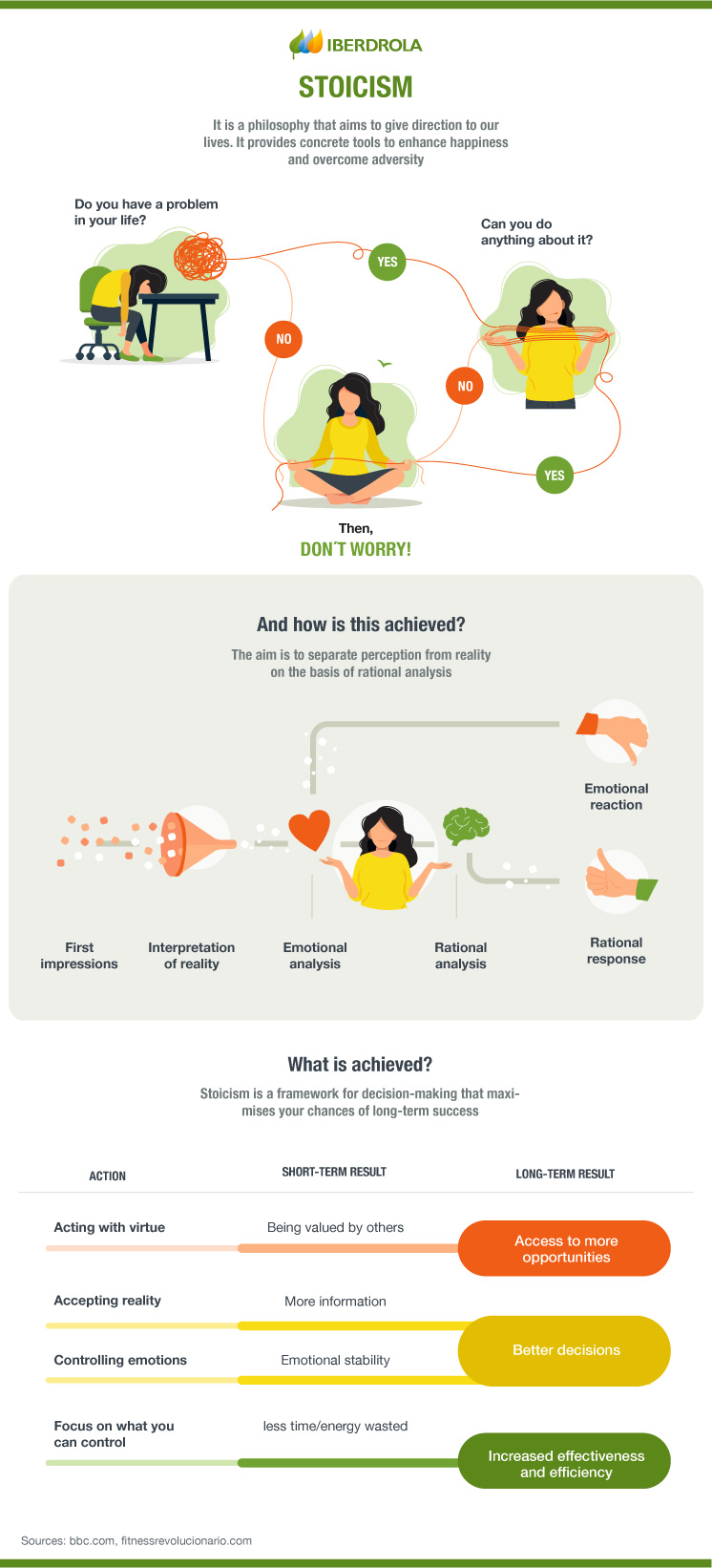STOICISM
Stoicism, the value of reason in coping with chaos
Professional skills Training Human resources
In a world where crises follow one after another, daily life is frenetic and the elements that form it are tremendously liquid, stoicism is presented to successful entrepreneurs, personal trainers or writers as the best philosophy to help them live a full life, based on the value of reason and not trying to dominate that which is beyond our control.

Stoicism is a school of philosophy founded in the early 3rd century BC by Zeno of Citium. This philosopher, born in Cyprus, survived a shipwreck, but lost everything he possessed in it. He arrived in Athens, where he gave public lectures, but where, as a foreigner, he could not participate in the politics of the city. Indeed, the name of his philosophy comes from the place where he disseminated his thought; a 'stoa' or covered gallery that was located next to the city's Agora.
WHAT IS IT TO BE STOIC AND WHAT ARE ITS CHARACTERISTICS?
The word stoic, in its modern usage, refers to a person who is indifferent to pleasure, joy, as well as sorrow or pain. Not surprisingly, the dictionary of the Royal Academy of the Spanish Language (RAE) defines stoic in its first meaning as "Strong, equanimous in the face of misfortune" and the same is true of the Oxford dictionary which defines it as a person who suffers pain or problems without complaining or without showing what he feels. However, the Stoic doctrine is rather based on being guided by reason and, because you cannot control what happens around you, controlling what you think about what happens.
For this reason, stoicism focuses especially on the emotions, which it refers to as passions, and which it divides into good, bad and indifferent. The good ones are to be promoted, the indifferent ones are to be ignored and the bad ones are to be dealt with. Stoicism's reflection on this is that people are not disturbed by the things that happen, but by the opinions they have about those things that happen. So, it is a matter of confronting those opinions and, before taking them on board, questioning them as if they were hypotheses rather than firm facts. In this way, they can be refuted by seeking a more productive perspective and getting a rational response to those passions in order to turn them into healthy emotions.

SEE INFOGRAPHIC: Basic pillars of Stoic philososophy [PDF]
BASIC CHARACTERISTICS OF STOICISM: VIRTUE, TRANQUILLITY AND HAPPINESS
The aim of the Stoics was none other than to achieve happiness or self-realisation, a concept they referred to as eudaimonia. This is reached through moral virtue (or arete) and serenity (or ataraxia).
Virtue in the Stoics is about excellence and reaching one's destined potential. To this end, four qualities stand out: wisdom, justice, courage and discipline. All of these are always sifted by reason, which would lead one to seek wisdom, act justly, employ courage and nurture discipline.
If virtue is one of the angles of the triangle of happiness, the other is serenity or ataraxia. This is a kind of mental serenity that allows negative emotions not to dominate and thus makes it easier to act with virtue. According to the Stoics, it is precisely emotional reactions to negative situations that lead to a distorted perception of reality, as there is a tendency to confuse thoughts with facts. This, according to this school of philosophy, inevitably leads to mental agitation.
THE DICHOTOMY OF CONTROL
The so-called dichotomy of control is one of the most relevant terms in Stoicism and has evolved from the origins of this philosophical current to the present day. It is about knowing which things are within one's control and which are not. Among the former are, for example, the opinions, judgements or actions that one adopts, and it is on these that one should focus one's attention, bearing in mind that there are other things that cannot be controlled. In the words of Seneca: "The wise man is concerned with the intention of his actions, not with their results".
Modern stoicism proposes that this dichotomy becomes a trichotomy and a third option is added, which would be things over which one has partial control. An example would be a tennis match in which the outcome is not under total control because variables such as the skill of the opponent, the weather conditions or the expertise of the umpire influence the outcome. Therefore, in this example, the objective should not be to win the match but to play to the best of one's ability, as this can be controlled.
WHAT IS IT LIKE TO BE A STOIC TODAY? EXAMPLES OF STOICISM
One of the characteristics of Stoicism that made it one of the dominant philosophical currents was its practical nature; it was understood as a kind of toolbox that allowed them to move towards self-realisation. Therefore, and assuming that the true Stoic is an ideal to aim for, not a goal, some of these tools are as follows:
| Identifying what you can control and what you can't control
| Dealing with negative emotions and analysing them using reason
| Focusing on the present moment and avoid emotional suffering for the past or the future.
| Concern yourself with thoughts, avoiding dependence on external things.
| Writing a stoic diary in which to write down the important things of each day to analyse what went right, what went wrong and what remains to be done.




